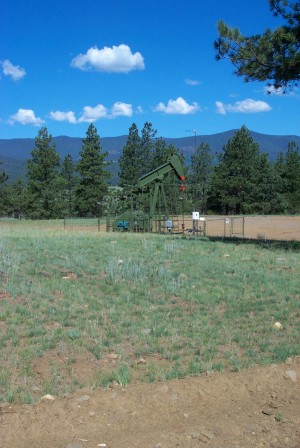Minimizing Surface Disturbance

Interim well pad reclamation, Vermejo Park Ranch
Well pads are often much larger than they need to be - sometimes exceeding several acres in size. At Ted Turner's Vermejo Park Ranch, however, the well pads are only 0.6 acres. (See Vermejo Park Ranch Coal Bed Methane Project Mineral Extraction Agreement Summary, in Oil and Gas at Your Door - a Landowner's Guide to Oil and Gas Development, Chapter III).
After the drilling phase if over, the portion of the drilling pad not needed for oil or gas production can be reclaimed. This is known as interim reclamation, and it is required by law in many states. Unfortunately, lack of enforcement by state agencies means that interim reclamation does not occur in many jurisdictions.
During the drilling phase, pad size can be reduced by drilling multiple wells from one site. For example, at the Vermejo Park Ranch two or more wells have been drilled from the same pad (see directional drilling).
Redesigning pits can decrease the amount of surface disturbance.
If a pitless drilling system is not used for drilling fluids, another approach may be to use a V-shaped pit instead of the traditional rectangular pit. This type of pit reduces water requirements, as well as the amount of surface disturbance.
The design is as follows: the open end of the "V" faces the drilling rig and the cross-sectional view resembles a squared-off funnel (about 10 feet deep with the upper 5 feet having slanted walls to a width of about 20 feet). Because the fluid must travel the full length of the pit, this design prevents mud from channeling between the discharge point and the suction point, and reduces the amount of water that must be added to maintain the desired fluid characteristics. In addition, because the V-shaped pit is long and narrow, it is easier to construct and leaves a smaller "footprint" at the site.[1]
A company installed a V-shaped reserve pit and compared the costs with those incurred at similar-sized wells using a traditional pit. The company determined that pit construction time was reduced by about 40 percent, water costs for the well were reduced by about 38 percent, and pit liner costs were reduced by about 43 percent. The total cost savings were about $10,800 per well.
It should be noted that whenever earthen pits are used to store wastes, they should be lined with multiple layers of synthetic fabric with leak detection devices between the layers.
For more information:
Sources:
- Railroad Commission of Texas, Oil and Gas Division. Waste Minimization in the Oil Field. Chapter 5. Page 5-3.
Tagged with: well pads, surface owner rights, surface owner protection, best practices
Follow Earthworks